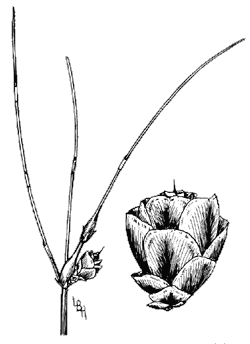Ephedraceae (ephedra family)
Ephedra spp.
English names: ephedra, joint fir, Mormon tea
Spanish name: canutillo (and several spelling variants)
 |
Description
These woody shrubs grow 2 to 5 feet (0.6-1.5 m) tall and wide. The terminal stems are thin, green, and essentially leafless. These are conifers more primitive than pine trees; they bear papery cones. (Their closest relative is the bizarre Welwitschia spp. of the Namib Desert, which looks like a beached green octopus but has the same cone structure as ephedra.) The various species are similar in general appearance; distinguishing among them requires close inspection.
Range
About 40 species occur in arid habitats in the northern hemisphere and South America. About half a dozen occur in the Sonoran Desert region.
Notes
The stems contain caffeine and ephedrine (a drug that acts like adrenalin/epinephrin). The closely related pseudoephedrine is now synthesized commercially and is an ingredient in commercial asthma and cold remedies, e.g., Sudafed®. Pseudoephedrine is also a precursor in the production of the dangerous illegal drug methamphetamine (“speed”). A tea with stimulant properties is made by steeping dried stems. It has been used medicinally to treat a variety of ailments including syphilis, diabetes, and pneumonia. A Chinese species is the source of ma huang, a tea so potent that it has caused deaths from overstimulation of the heart.
In the Gran Desierto and Algodones Dunes ephedras grow much larger than usual; bushes 15 feet (4.6 m) across can be found. Occasionally a dune migrates away from one of these plants, exposing many feet of stems that had been slowly buried as the dune marched over it and the bush managed to keep a couple of feet of living stems in the sunlight. Observations of such blowouts suggest that these plants are very old, though they have not been documented to live more than about 50 years. We don’t yet know how long ephedras live; they have not been thoroughly studied by biologists.